Water Temperature Ensemble Forecasts: Implementation Using the CEQUEAU Model on Two Contrasted River Systems
Abstract
:1. Introduction
2. Materials and Methods
2.1. Model and Modeling Framework
2.2. Ensemble Forecasting System
2.3. Model Calibration
2.4. Forecasts Verification and Explicit Consideration of Uncertainty
2.5. Study Sites and Data
2.5.1. Nechako
2.5.2. Southwest Miramichi
2.5.3. Meteorological and Hydrological Data
3. Results
3.1. Model Calibration and Evaluation
3.2. Meteorological Forecasts Evaluation
3.3. Hydrological and Thermal Forecasts Evaluation
3.4. Uncertainty and Reliability of the Forecasts
4. Discussion
5. Conclusions
Acknowledgments
Author Contributions
Conflicts of Interest
References
- Fry, F.E.J. The effect of environmental factors on the physiology of fish. Fish Physiol. 1971, 6, 1–98. [Google Scholar]
- Ward, J.V.; Stanford, J.A. Thermal responses in the evolutionary ecology of aquatic insects. Annu. Rev. Entomol. 1982, 27, 97–117. [Google Scholar] [CrossRef]
- McCullough, D.A. Are coldwater fish populations of the United States actually being protected by temperature standards? Freshw. Rev. 2010, 3, 147–199. [Google Scholar] [CrossRef]
- McCullough, D.A.; Spalding, S.; Sturdevant, D.; Hicks, M. Summary of Technical Literature Examining the Physiological Effects of Temperature on Salmonids; US Environmental Protection Agency: Washington, DC, USA, 2001; 119p, ISBN EPA-910-D-01-005.
- Ouellet, V.; Pierron, F.; Mingelbier, M.; Fournier, M.; Marlène, F.; Couture, P. Thermal Stress Effects on Gene Expression and Phagocytosis in the Common Carp (Cyprinus Carpio): A Better Understanding of the Summer 2001 St. Lawrence River Fish Kill. Open Fish Sci. J. 2013, 6, 99–106. [Google Scholar] [CrossRef]
- Sullivan, K.; Martin, D.J.; Cardwell, R.D.; Toll, J.E.; Steven, D. An analysis of the effects of temperature on salmonids of the Pacific Northwest with implications for selecting temperature criteria. Histochemistry 2000, 90, 85–97. [Google Scholar]
- Caissie, D. The thermal regime of rivers: A review. Freshw. Biol. 2006, 51, 1389–1406. [Google Scholar] [CrossRef]
- Maheu, A.; Poff, N.L.; St-Hilaire, A. A Classification of Stream Water Temperature Regimes in the Conterminous USA. River Res. Appl. 2016, 32, 896–906. [Google Scholar] [CrossRef]
- Ward, J.V.; Stanford, J.A. Ecological factors controlling streams zoobenthos with emphasis on thermal modification of regulated streams. In The Ecology of Regulated Streams; Ward, J.V., Stanford, J.A., Eds.; Plenum Press: New York, NY, USA, 1979; pp. 35–56. [Google Scholar]
- Crisp, D.T. Thermal “resetting” of streams by reservoir releases with special reference to effects on salmonid fishes. In Regulated Streams: Advances in Ecology; Craig, J.F., Kemper, J.B., Eds.; Plenum Press: New York, NY, USA, 1987; pp. 163–182. [Google Scholar]
- Poff, N.L.; Hart, D.D. How Dams Vary and Why It Matters for the Emerging Science of Dam Removal. Bioscience 2002, 52, 659–668. [Google Scholar] [CrossRef]
- Gu, R.; Montgomery, S.; Austin, T. Al Quantifying the effects of stream discharge on summer river temperature. Hydrol. Sci. 1998, 43, 885–904. [Google Scholar] [CrossRef]
- Cole, J.C.; Maloney, K.O.; Schmid, M.; McKenna, J.E. Developing and testing temperature models for regulated systems: A case study on the Upper Delaware River. J. Hydrol. 2014, 519, 588–598. [Google Scholar] [CrossRef]
- Benyahya, L.; Caissie, D.; St-Hilaire, A.; Ouarda, T.B.M.; Bobée, B. A Review of Statistical Water Temperature Models. Can. Water Resour. J. 2007, 32, 179–192. [Google Scholar] [CrossRef]
- Pike, A.; Danner, E.; Boughton, D.; Melton, F.; Nemani, R.; Rajagopalan, B.; Lindley, S. Forecasting river temperatures in real time using a stochastic dynamics approach. Water Resour. Res. 2013, 49, 5168–5182. [Google Scholar] [CrossRef]
- Olden, J.D.; Naiman, R.J. Incorporating thermal regimes into environmental flows assessments: Modifying dam operations to restore freshwater ecosystem integrity. Freshw. Biol. 2010, 55, 86–107. [Google Scholar] [CrossRef]
- Breau, C. Knowledge of Fish Physiology Used to Set Water Temperature Thresholds for In-Season Closures of Atlantic Salmon (Salmo salar) Recreational Fisheries; Research Document 2012/163; Fisheries and Oceans Canada: Moncton, NB, Canada, 2012.
- Webb, B.W.; Hannah, D.M.; Moore, R.D.; Brown, L.E.; Nobilis, F. Recent advances in stream and river temperature research. Hydrol. Process. 2008, 22, 902–918. [Google Scholar] [CrossRef]
- Huang, B.; Langpap, C.; Adams, R.M. Using instream water temperature forecasts for fisheries management: An application in the Pacific Northwest. J. Am. Water Resour. Assoc. 2011, 47, 861–876. [Google Scholar] [CrossRef]
- Danner, E.M.; Melton, F.S.; Pike, A.; Hashimoto, H.; Michaelis, A.; Rajagopalan, B.; Caldwell, J.; Dewitt, L.; Lindley, S.; Nemani, R.R. River temperature forecasting: A coupled-modeling framework for management of river habitat. IEEE J. Sel. Top. Appl. Earth Obs. Remote Sens. 2012, 5, 1752–1760. [Google Scholar] [CrossRef]
- Huang, B.; Langpap, C.; Adams, R.M. The value of in-stream water temperature forecasts for fisheries management. Contemp. Econ. Policy 2012, 30, 247–261. [Google Scholar] [CrossRef]
- Casati, B.; Wilson, L.J.; Stephenson, D.B.; Nurmi, P.; Ghelli, A.; Pocernich, M.; Damrath, U.; Ebert, E.E.; Brown, B.G.; Mason, S.; et al. Forecast verification: Current status and future directions. Meteorol. Appl. 2008, 15, 3–18. [Google Scholar] [CrossRef]
- Boucher, M.A.; Anctil, F.; Perreault, L.; Tremblay, D. A comparison between ensemble and deterministic hydrological forecasts in an operational context. Adv. Geosci. 2011, 29, 85–94. [Google Scholar] [CrossRef]
- Thiboult, A.; Anctil, F.; Boucher, M.A. Accounting for three sources of uncertainty in ensemble hydrological forecasting. Hydrol. Earth Syst. Sci. 2016, 20, 1809–1825. [Google Scholar] [CrossRef]
- Cloke, H.L.; Pappenberger, F. Ensemble flood forecasting: A review. J. Hydrol. 2009, 375, 613–626. [Google Scholar] [CrossRef]
- Bartholow, J. Modeling uncertainty: Quicksand for water temperature modeling. Hydrol. Sci. Technol. 2003, 19, 221–232. [Google Scholar]
- Yearsley, J.R. A semi-Lagrangian water temperature model for advection-dominated river systems. Water Resour. Res. 2009, 45, 1–19. [Google Scholar] [CrossRef]
- Hague, M.J.; Patterson, D.A. Evaluation of Statistical River Temperature Forecast Models for Fisheries Management. North Am. J. Fish. Manag. 2014, 34, 132–146. [Google Scholar] [CrossRef]
- Bal, G.; Rivot, E.; Baglinière, J.-L.; White, J.; Prévost, E. A Hierarchical Bayesian Model to Quantify Uncertainty of Stream Water Temperature Forecasts. PLoS ONE 2014, 9, e115659. [Google Scholar] [CrossRef] [PubMed]
- Morin, G.; Couillard, D. Predicting river temperatures with a hydrological model. In Encyclopedia of Fluid Mechanics; Gulf Publishing Compagny: Hudson, TX, USA, 1990; pp. 171–209. [Google Scholar]
- St-Hilaire, A.; Morin, G.; El-Jabi, N.; Caissie, D. Water temperature modelling in a small forested stream: Implication of forest canopy and soil temperature. Can. J. Civ. Eng. 2000, 27, 1095–1108. [Google Scholar] [CrossRef]
- St-Hilaire, A.; Boucher, M.-A.; Chebana, F.; Ouellet-Proulx, S.; Zhou, Q.-X.; Larabi, S.; Dugdale, S. Breathing a new life to an older model: The CEQUEAU tool for flow and water temperature simulations and forecasting. In Proceedings of the 22nd Canadian Hydrotechnical Conference, Montreal, QC, Canada, 29 April–2 May 2015. [Google Scholar]
- Hansen, N.; Ostermeier, A. Adapting Arbitrary Normal Mutation Distributions in Evolution Strategies: The Covariance Matrix Adaptation. In Proceedings of the 1996 IEEE International Conference on Evolutionary Computation, Nagoya, Japan, 20–22 May 1996; pp. 312–317. [Google Scholar]
- Hamill, T.M.; Colucci, S.J. Verification of Eta–RSM Short-Range Ensemble Forecasts. Mon. Weather Rev. 1997, 125, 1312–1327. [Google Scholar] [CrossRef]
- Hersbach, H. Decomposition of the Continuous Ranked Probability Score for Ensemble Prediction Systems. Weather Forecast. 2000, 15, 559–570. [Google Scholar] [CrossRef]
- Laio, F.; Tamea, S. Verification tools for probabilistic forecasts of continuous hydrological variables. Hydrol. Earth Syst. Sci. Discuss. 2006, 3, 2145–2173. [Google Scholar] [CrossRef]
- Gneiting, T.; Raftery, A.E. Strictly Proper Scoring Rules, Prediction, and Estimation. J. Am. Stat. Assoc. 2007, 102, 359–378. [Google Scholar] [CrossRef]
- Gneiting, T.; Raftery, A.E.; Westveld, A.H.; Goldman, T. Calibrated Probabilistic Forecasting Using Ensemble Model Output Statistics and Minimum CRPS Estimation. Mon. Weather Rev. 2005, 133, 1098–1118. [Google Scholar] [CrossRef]
- Macdonald, J.S.; Morrison, J.; Patterson, D.A. The efficacy of reservoir flow regulation for cooling migration temperature for sockeye salmon in the Nechako River watershed of British Columbia. North Am. J. Fish. Manag. 2012, 32, 415–427. [Google Scholar] [CrossRef]
- Brier, G.W. Verification of forecasts expressed in terms of probability. Mon. Weather Rev. 1950, 78, 1–3. [Google Scholar] [CrossRef]
- Stanski, H.; Wilson, L.; Burrows, W. Survey of Common Verification Methods in Meteorology; World Weather Watch Technology Report 8; World Meteorological Organization: Geneva, Switzerland, 1989. [Google Scholar]
- Boudreau, K. Nechako Watershed Council Report: Assessment of Potential Flow Regimes for the Nechako Watershed; 4Thought Solutions Inc.: Vancouver, BC, Canada, 2005. [Google Scholar]
- Ahmadi-Nedushan, B.; St.-Hilaire, A.; Ouarda, T.B.M.J.; Bilodeau, L.; Robichaud, É.; Thiémonge, N.; Bobée, B. Predicting river water temperatures using stochastic models: Case study of the Moisie River (Québec, Canada). Hydrol. Process. 2007, 21, 21–34. [Google Scholar] [CrossRef]
- Envirocon Ltd. Documentation of the Nechako Unsteady State Water Temperature Model; Envirocon Ltd.: Vancouver, BC, Canada, 1984. [Google Scholar]
- Caissie, D.; Breau, C.; Hayward, J.; Cameron, P. Water Temperature Characteristics within the Miramichi and Restigouche Rivers; Research Document 2012/165; Fisheries and Oceans Canada: Moncton, NB, Canada, 2012.
- Temperature Threshold to Define Management Strategies for Atlantic salmon (Salmo salar) Fisheries under Environmentally Stressful Conditions; Canadian Science Advisory Secretariat Science Advisory Report 2012/019; Fisheries and Oceans Canada: Moncton, NB, Canada, 2012.
- Tetens, O. Uber einige meteorologische. Begr. Zeitschrift fur Geophys. 1930, 6, 297–309. [Google Scholar]
- Gagnon, N.; Beauregard, S.; Muncaster, R.; Abrahamowicz, M.; Lahlou, R.; Lin, H. Improvements to the Global Ensemble Prediction System (GEPS) from Version 3.1.0 to Version 4.0.0; Technical Note; Canadian Meteorological Centre: Dorval, QC, Canada, 2014.
- Dugdale, S.J.; St-Hilaire, A.; Curry, R.A. Automating physiography and flow routing inputs to the CEQUEAU hydrological model: Sensitivity testing on the St. John River Watershed. J. Hydroinform. 2017, 19, 469–492. [Google Scholar] [CrossRef]
- Troccoli, A.; Morcrette, J.J. Skill of direct solar radiation predicted by the ECMWF global atmospheric model over Australia. J. Appl. Meteorol. Climatol. 2014, 53, 2571–2588. [Google Scholar] [CrossRef]
- Kang, T.H.; Kim, Y.O.; Hong, I.P. Comparison of pre- and post-processors for ensemble streamflow prediction. Atmos. Sci. Lett. 2010, 11, 153–159. [Google Scholar] [CrossRef]
- Verkade, J.S.; Brown, J.D.; Reggiani, P.; Weerts, A.H. Post-processing ECMWF precipitation and temperature ensemble reforecasts for operational hydrologic forecasting at various spatial scales. J. Hydrol. 2013, 501, 73–91. [Google Scholar] [CrossRef]
- Gudmundsson, L.; Bremnes, J.B.; Haugen, J.E.; Engen-Skaugen, T. Technical Note: Downscaling RCM precipitation to the station scale using statistical transformations—A comparison of methods. Hydrol. Earth Syst. Sci. 2012, 16, 3383–3390. [Google Scholar] [CrossRef]
- Raftery, A.E.; Gneiting, T.; Balabdaoui, F.; Polakowski, M. Using Bayesian Model Averaging to Calibrate Forecast Ensembles. Mon. Weather Rev. 2005, 133, 1155–1174. [Google Scholar] [CrossRef]
- Triton Environmental Consultants. Personal communication, 1 January 2016.
- Caissie, D.; Thistle, M.E.; Benyahya, L. River temperature forecasting: Case study for Little Southwest Miramichi River (New Brunswick, Canada). Hydrol. Sci. J. 2016, 62, 683–697. [Google Scholar]
- Matte, S.; Boucher, M.-A.; Boucher, V.; Fortier Filion, T.-C. Moving beyond the cost-loss ratio: Economic assessment of streamflow forecasts for a risk-averse decision maker. Hydrol. Earth Syst. Sci. 2017, 21, 2967–2986. [Google Scholar] [CrossRef]
- Weijs, S.V.; Schoups, G.; Van De Giesen, N. Why hydrological predictions should be evaluated using information theory. Hydrol. Earth Syst. Sci. 2010, 14, 2545–2558. [Google Scholar] [CrossRef]
- Beven, K.J. Prophecy, reality and uncertainty in distributed hydrological modelling. Adv. Water Res. 1993, 16, 41–51. [Google Scholar] [CrossRef]
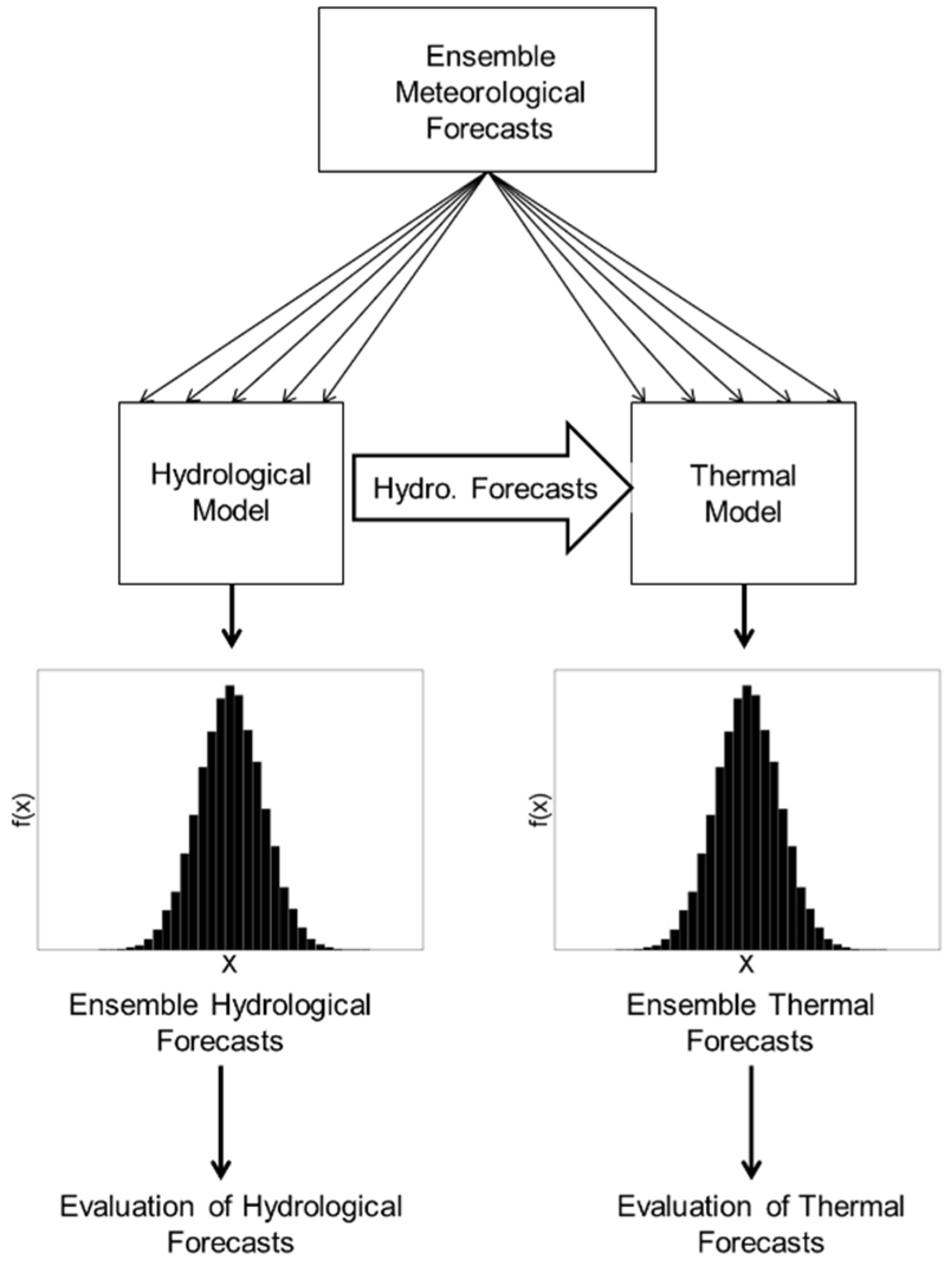
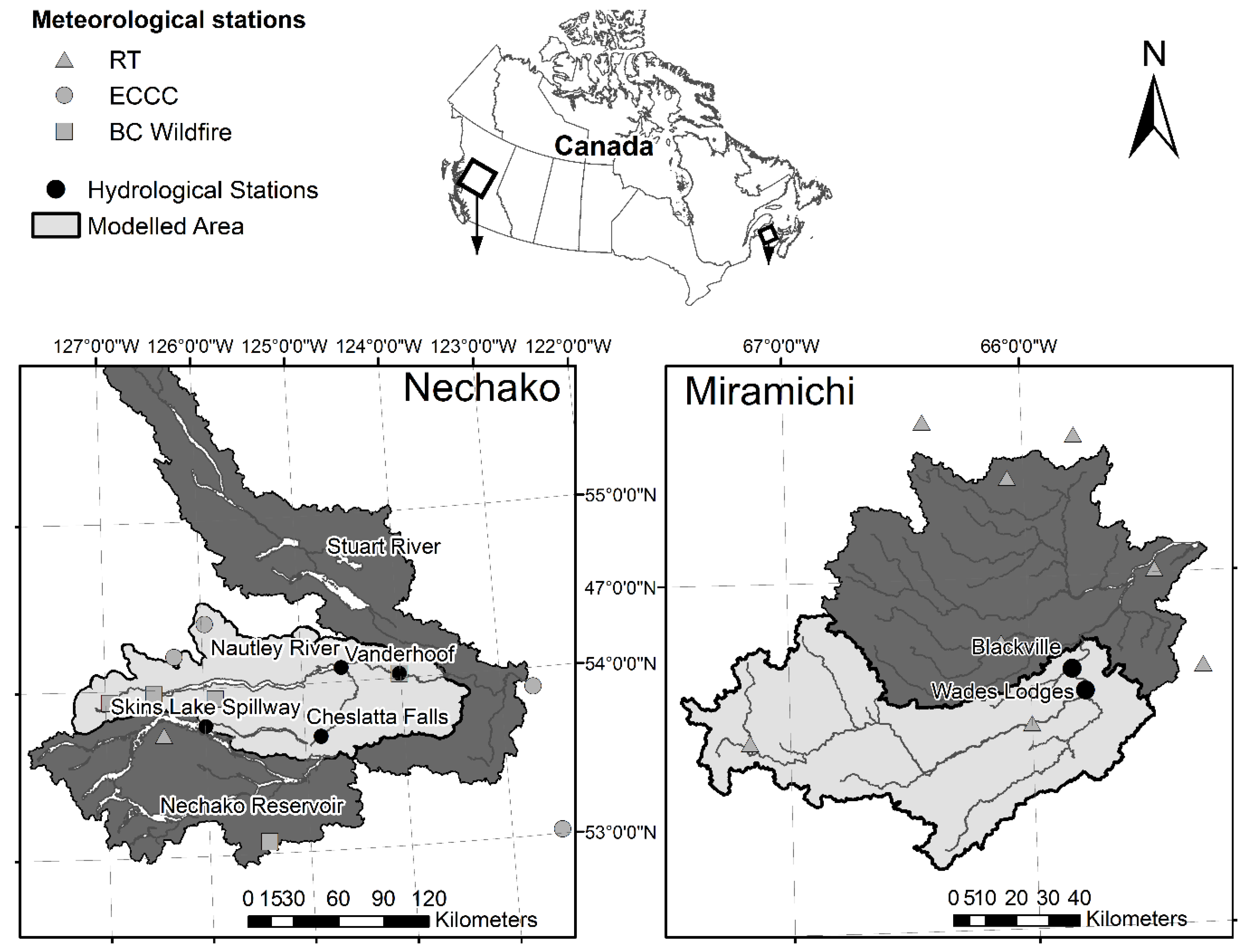

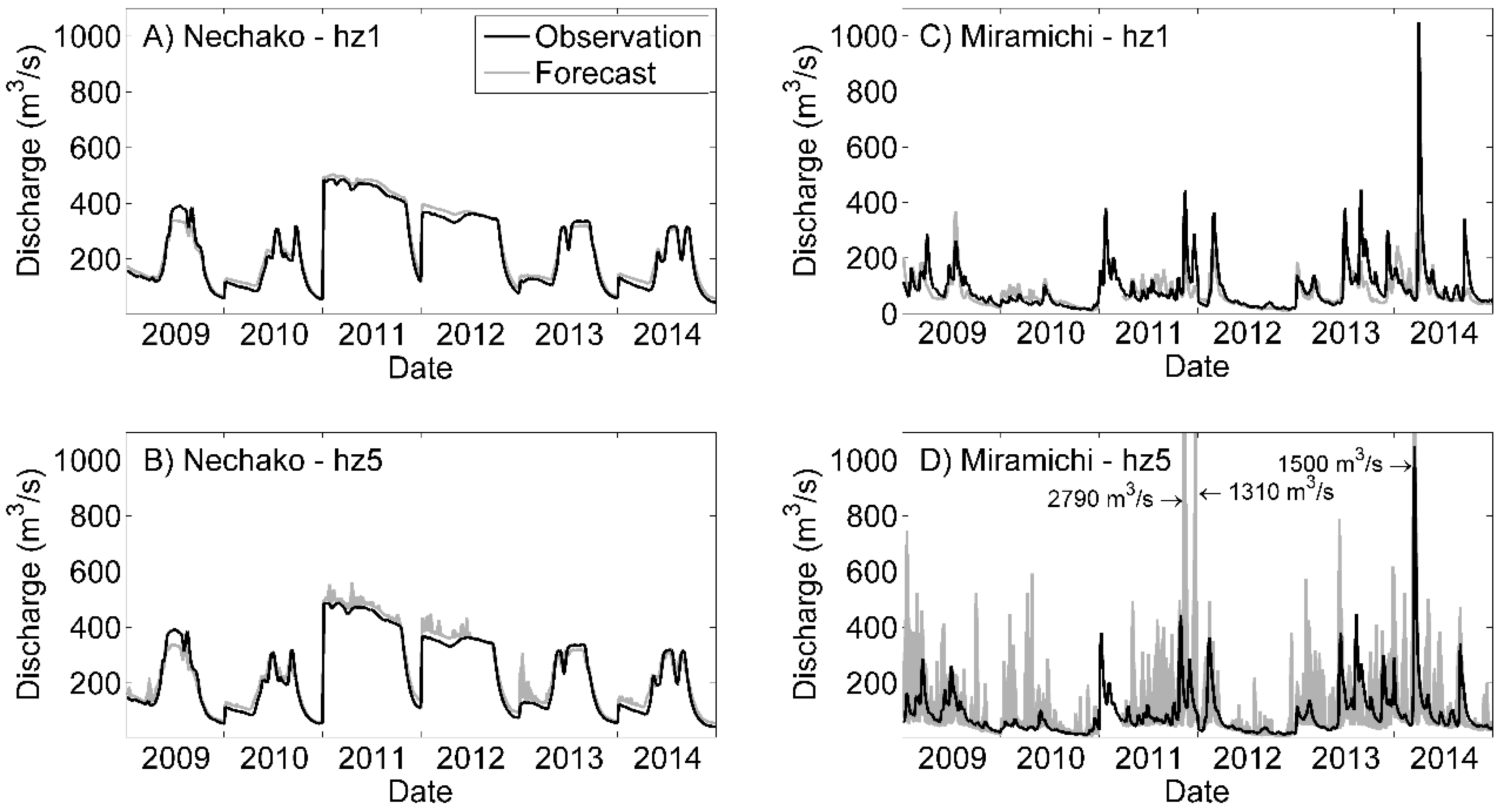
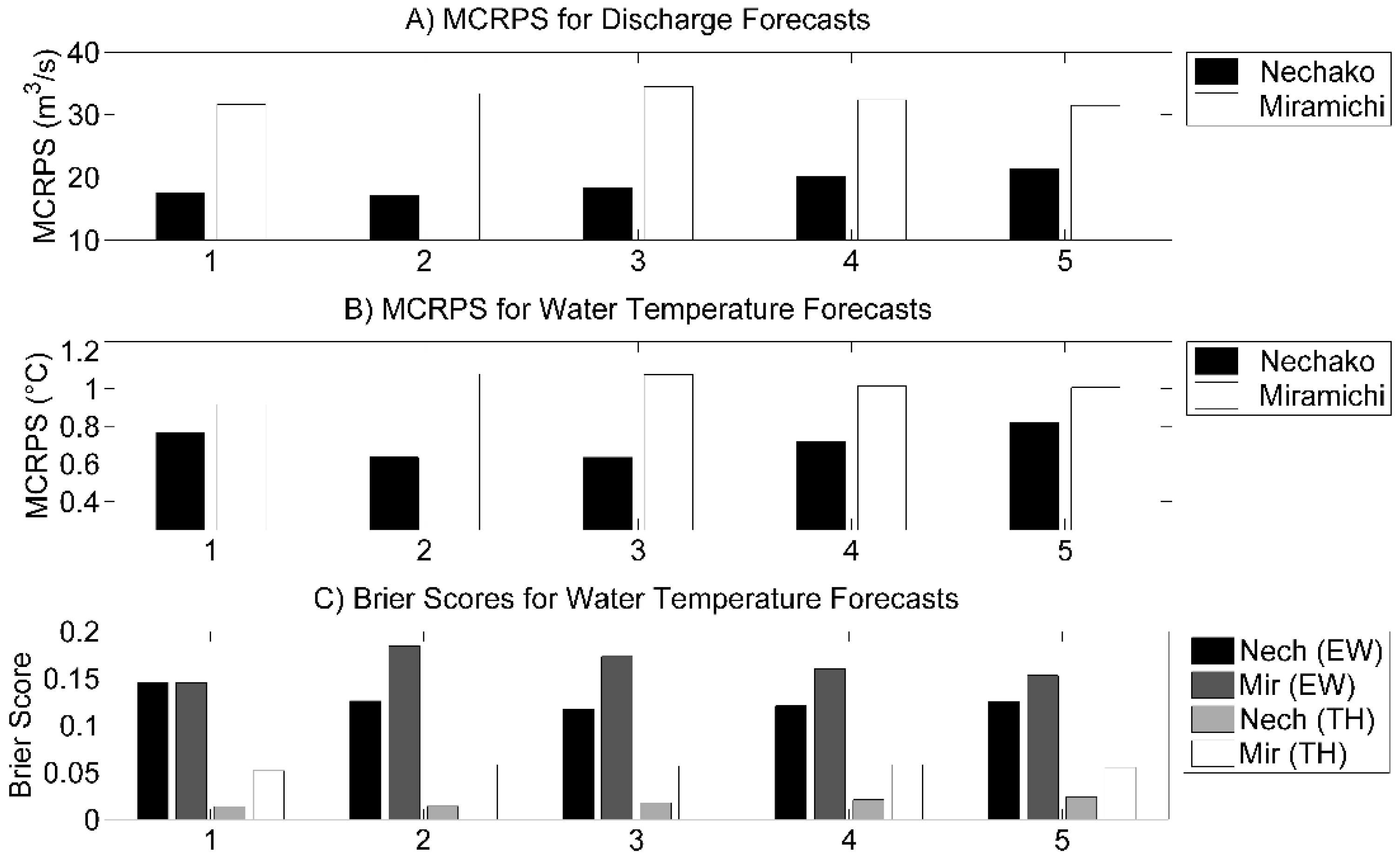

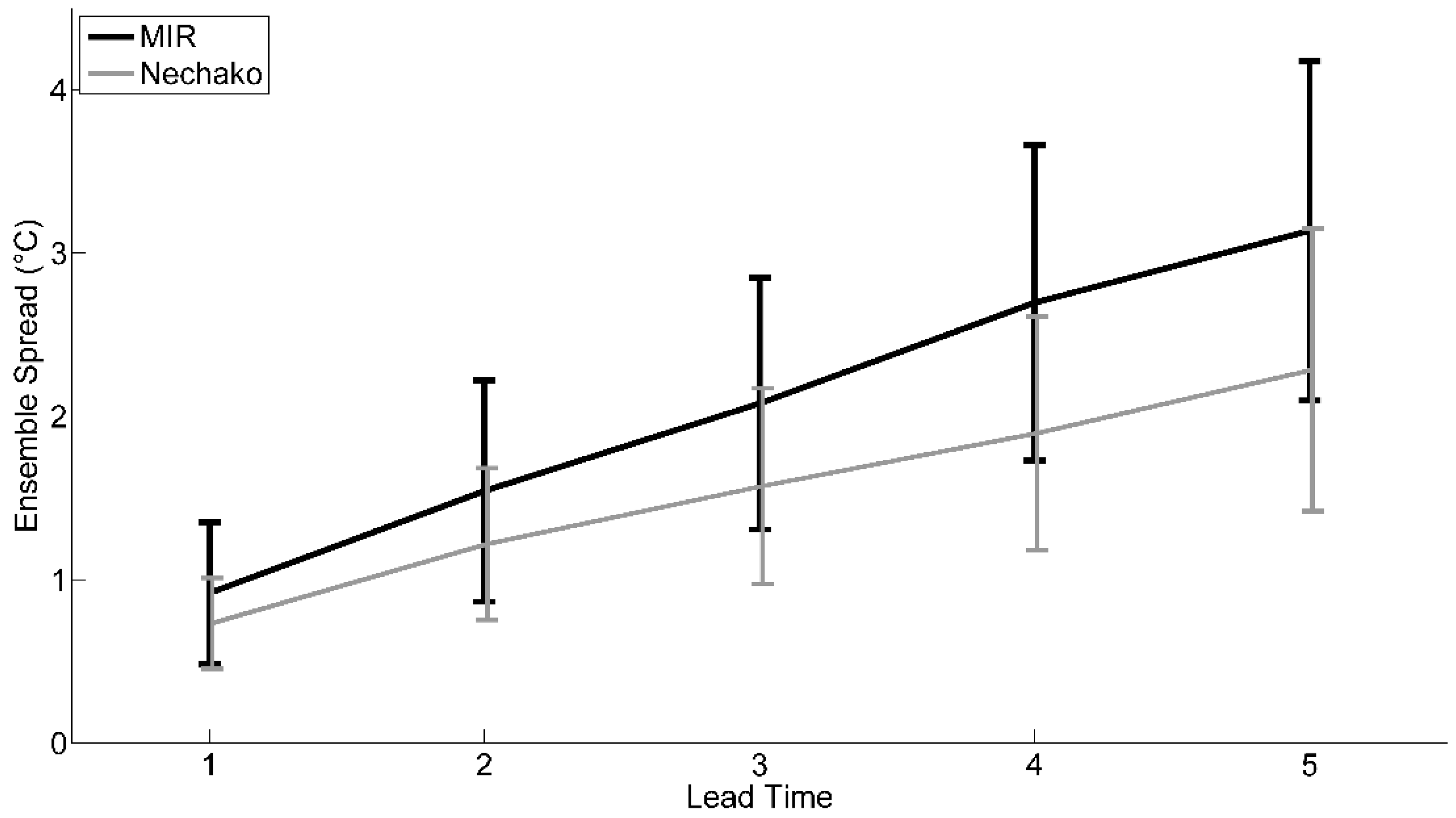
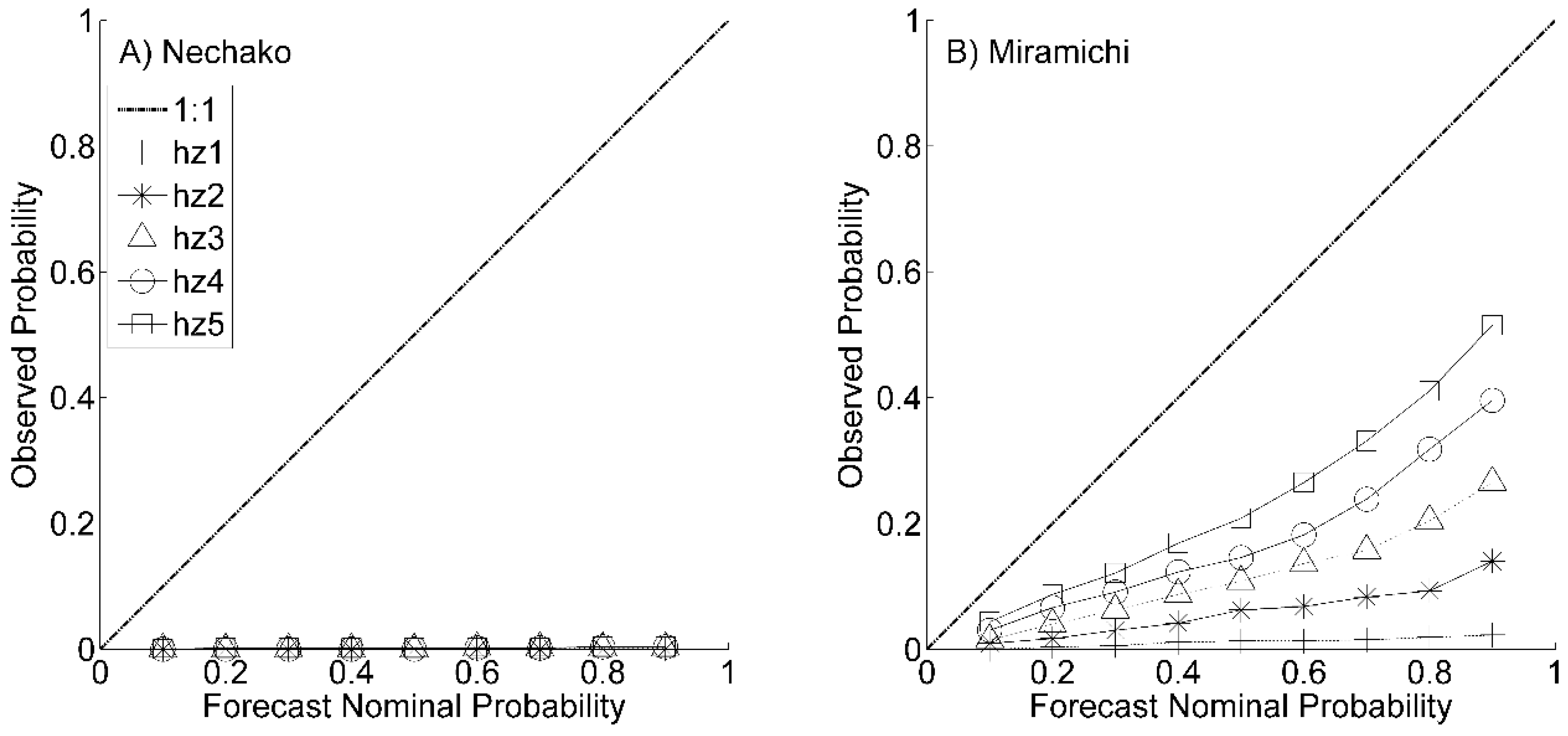
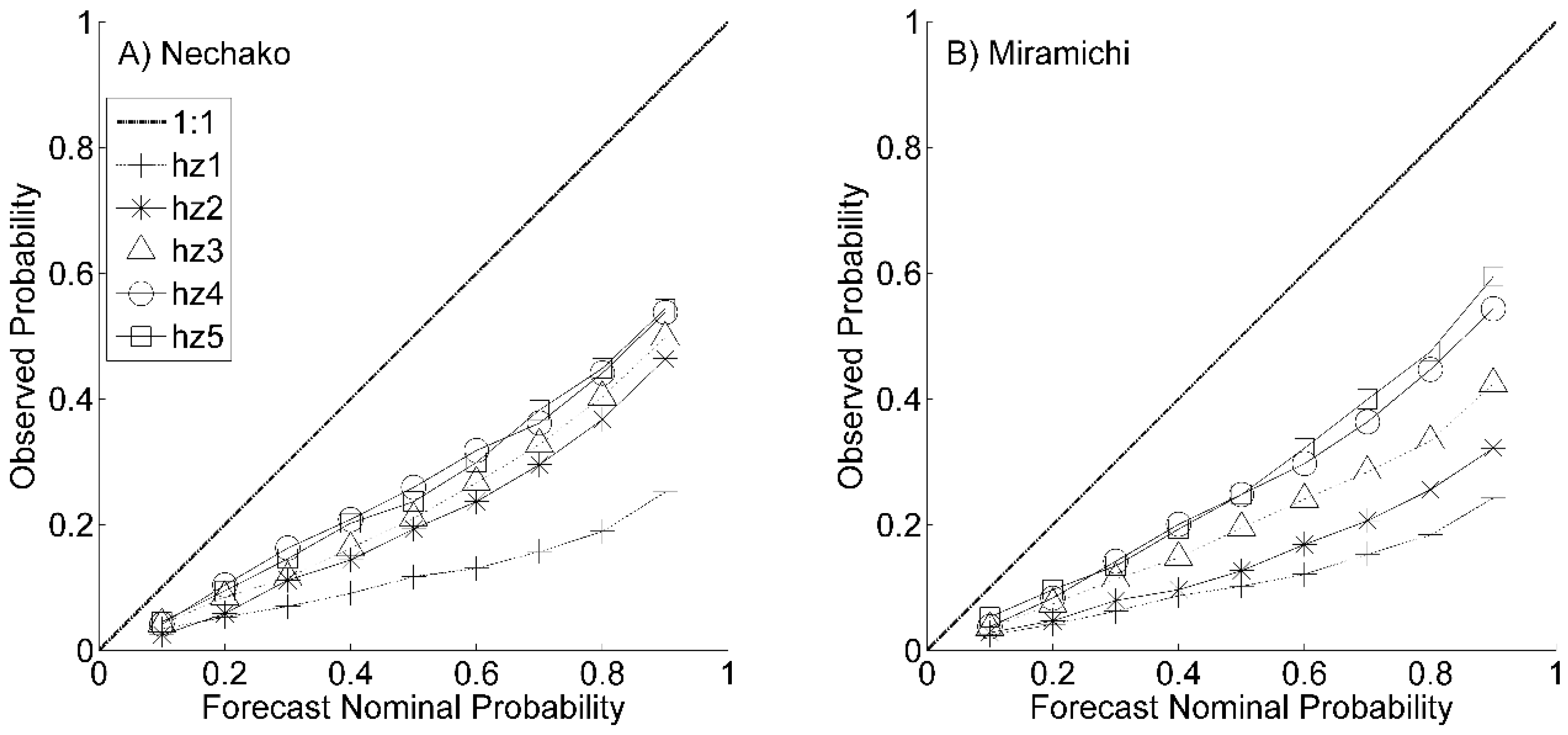
| Discharge | Water Temperature | |||||||||||||
|---|---|---|---|---|---|---|---|---|---|---|---|---|---|---|
| Year-Round | Summer | |||||||||||||
| NS | Bias (m3/s) | Relative Bias | RMSE (°C) | Bias (°C) | RMSE (°C) | Bias (°C) | ||||||||
| Period | NECH | MIR | NECH | MIR | NECH | MIR | NECH | MIR | NECH | MIR | NECH | MIR | NECH | MIR |
| Calibration | 0.96 | 0.84 | 8.87 | −3.03 | 0.12 | 0.01 | 1.38 | 1.37 | 0.24 | −0.54 | 0.78 | 1.23 | 0.43 | −0.76 |
| Validation | 0.86 | 0.72 | −10.4 | −18.6 | 0.13 | 0.13 | 1.54 | 1.51 | 0.2 | 0.09 | 0.95 | 1.46 | 0.37 | 0.18 |
| Hz1 | Hz2 | Hz3 | Hz4 | Hz5 | ||||||
|---|---|---|---|---|---|---|---|---|---|---|
| NECH | MIR | NECH | MIR | NECH | MIR | NECH | MIR | NECH | MIR | |
| tmin (°C) | 3.30 | 1.97 | 3.50 | 2.14 | 3.70 | 2.25 | 3.70 | 2.26 | 3.80 | 2.47 |
| tmax (°C) | 1.60 | 1.35 | 1.50 | 1.42 | 1.60 | 1.53 | 1.60 | 1.66 | 1.80 | 1.81 |
| pTot (mm) | 0.70 | 2.03 | 1.00 | 2.18 | 1.60 | 2.04 | 2.00 | 2.87 | 2.80 | 3.00 |
| RS (MJ/m2) | 2.50 | 2.32 | 2.50 | 2.40 | 2.50 | 2.76 | 2.70 | 3.75 | 3.10 | 3.25 |
| CC (0–1) | 0.15 | 0.16 | 0.14 | 0.16 | 0.14 | 0.17 | 0.14 | 0.18 | 0.15 | 0.19 |
| U (km/h) | 1.35 | 2.13 | 1.36 | 2.05 | 1.34 | 2.07 | 1.29 | 2.18 | 1.55 | 2.16 |
| ea (mm Hg) | 3.17 | 1.24 | 3.10 | 1.19 | 3.04 | 1.19 | 2.96 | 1.22 | 3.06 | 1.28 |
| Nechako | |||||
| Hz1 | Hz2 | Hz3 | Hz4 | Hz5 | |
| MAE (°C) | 0.49 | 0.58 | 0.55 | 0.54 | 0.68 |
| Miramichi (LSWM) * | |||||
| Hz1 | Hz2 | Hz3 | Hz4 | Hz5 | |
| RMSE (°C) | 0.87 | 1.24 | 1.48 | - | - |
| Bias | −0.01 | −0.03 | −0.03 | - | - |
© 2017 by the authors. Licensee MDPI, Basel, Switzerland. This article is an open access article distributed under the terms and conditions of the Creative Commons Attribution (CC BY) license (http://creativecommons.org/licenses/by/4.0/).
Share and Cite
Ouellet-Proulx, S.; St-Hilaire, A.; Boucher, M.-A. Water Temperature Ensemble Forecasts: Implementation Using the CEQUEAU Model on Two Contrasted River Systems. Water 2017, 9, 457. https://doi.org/10.3390/w9070457
Ouellet-Proulx S, St-Hilaire A, Boucher M-A. Water Temperature Ensemble Forecasts: Implementation Using the CEQUEAU Model on Two Contrasted River Systems. Water. 2017; 9(7):457. https://doi.org/10.3390/w9070457
Chicago/Turabian StyleOuellet-Proulx, Sébastien, André St-Hilaire, and Marie-Amélie Boucher. 2017. "Water Temperature Ensemble Forecasts: Implementation Using the CEQUEAU Model on Two Contrasted River Systems" Water 9, no. 7: 457. https://doi.org/10.3390/w9070457





